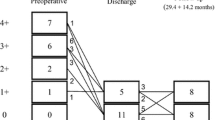Abstract
Objective
We assessed the long-term outcomes of the loop technique with ring annuloplasty for mitral regurgitation from our > 10-year experience.
Methods
We retrospectively reviewed 362 patients who underwent the loop technique with ring annuloplasty via median sternotomy or right mini-thoracotomy for mitral regurgitation. The median follow-up duration was 4.1 years (interquartile range 2.3–5.8 years).
Results
This study involved 147 women and 215 men (median age, 66.5 years). Mitral regurgitation was caused by Barlow’s disease in 27 patients. Seven patients required reoperations (recurrent regurgitation caused by technical issues, n = 3; progression of degenerative disease, n = 4). The 5- and 10-year cumulative incidences of reoperation considering death as the competing event were 1.4% and 5.4%, respectively. The 5- and 10-year postoperative cumulative incidences of moderate-to-severe recurrent mitral regurgitation were 4.7% and 13.0%, respectively. Residual regurgitation ≥ mild (hazard ratio, 6.99; 95% confidence interval, 1.520–32.12; P = .012) was an independent risk factor for reoperation. The independent risk factors for moderate-to-severe recurrent regurgitation were residual regurgitation ≥ mild (hazard ratio, 9.60; 95% confidence interval, 3.042–30.31; P < .001) and the loop-in-loop technique (hazard ratio, 3.40; 95% confidence interval, 1.058–10.90; P = .040). The median mean pressure gradient was sustained at almost 3.5 mmHg for > 7 years.
Conclusions
The loop technique with ring annuloplasty provided excellent results with good hemodynamics beyond the mid-term. Residual regurgitation ≥ mild and the loop-in-loop technique may not be preferable for durable outcomes.




Similar content being viewed by others
Abbreviations
- BMI:
-
Body mass index
- BSA:
-
Body surface area
- CI:
-
Confidence interval
- EF:
-
Ejection fraction
- Inf:
-
Infinity
- IQR:
-
Interquartile range
- LVDd:
-
Left-ventricular diastolic dimension
- NYHA:
-
New York Heart Association
- MV:
-
Mitral valve
- MR:
-
Mitral valve regurgitation
- PG:
-
Pressure gradient
- ePTFE:
-
Expanded polytetrafluoroethylene
- SAM:
-
Systolic anterior leaflet motion
References
Lawrie GM, Earle EA, Earle NR. Feasibility and intermediate term outcome of repair of prolapsing anterior mitral leaflets with artificial chordal replacement in 152 patients. Ann Thorac Surg. 2006;81:849–56.
David TE, Armstrong S, Ivanov J. Chordal replacement with polytetrafluoroethylene sutures for mitral valve repair: a 25-year experience. J Thorac Cardiovasc Surg. 2013;145:1563–9.
Hata H, Fujita T, Shimahara Y, Sato S, Ishibashi-Ueda H, Kobayashi J. A 25-year study of chordal replacement with expanded polytetrafluoroethylene in mitral valve repair. Interact Cardiovasc Thorac Surg. 2015;20:463–8.
Falk V, Seeburger J, Czesla M, Borger MA, Willige J, Kuntze T, et al. How does the use of polytetrafluoroethylene neochordae for posterior mitral valve prolapse (loop technique) compare with leaflet resection? A prospective randomized trial. J Thorac Cardiovasc Surg. 2008;136:1200–6.
Shibata T, Kato Y, Motoki M, Takahashi Y, Morisaki A, Nishimura S, et al. Mitral valve repair with loop technique via median sternotomy in 180 patients. Eur J Cardiothorac Surg. 2015;47:491–6.
Borger MA, Kaeding AF, Seeburger J, Melnitchouk S, Hoebartner M, Winkfein M, et al. Minimally invasive mitral valve repair in Barlow’s disease: early and long-term results. J Thorac Cardiovasc Surg. 2014;148:1379–85.
Murphy DA, Moss E, Binongo J, Miller JS, Macheers SK, Sarin EL, et al. The expanding role of endoscopic robotics in mitral valve surgery: 1,257 consecutive procedures. Ann Thorac Surg. 2015;100:1675–81.
David TE, David CM, Tsang W, Lafreniere-Roula M, Manlhiot C. Long-term results of mitral valve repair for regurgitation due to leaflet prolapse. J Am Coll Cardiol. 2019;74:1044–53.
Ram E, Schwammenthal E, Cohen H, Kogan A, Peled Y, Sternik L, et al. Outcomes of degenerative mitral valve repair surgery for anterior, posterior, and bileaflet pathology. Ann Thorac Surg. 2020;110:934–42.
Motomura N, Miyata H, Tsukihara H, Takamoto S, Japan Cardiovascular Surgery Database Organization. Risk model of thoracic aortic surgery in 4707 cases from a nationwide single-race population through a web-based data entry system: the first report of 30-day and 30-day operative outcome risk models for thoracic aortic surgery. Circulation. 2008;118:153–9.
Morisaki A, Takahashi Y, Fujii H, Sakon Y, Murakami T, Shibata T. Loop technique with ink-dot marking test: an alternative strategy to the ink test. J Thorac Cardiovasc Surg Tech. 2020;3:110–21.
Murashita T, Okada Y, Fujiwara H, Kanemitsu H, Fukunaga N, Konishi Y, et al. Mechanism of and risk factors for reoperation after mitral valve repair for degenerative mitral regurgitation. Circ J. 2013;77:2050–5.
Imielski B, Malaisrie SC, Pham DT, Kruse J, Andrei AC, Liu M, et al. The impact of intraoperative residual mild regurgitation after repair of degenerative mitral regurgitation. J Thorac Cardiovasc Surg. 2021;161:1215–24.
Tatum JM, Bowdish ME, Mack WJ, Quinn AM, Cohen RG, Hackmann AE, et al. Outcomes after mitral valve repair: a single-center 16-year experience. J Thorac Cardiovasc Surg. 2017;154:822-30.e2.
Okamoto K, Yozu R, Kudo M. Loop-in-loop technique in mitral valve repair via minithoracotomy. Ann Thorac Surg. 2012;93:1329–30.
Alfieri O, Lapenna E. Systolic anterior motion after mitral valve repair: where do we stand in 2015? Eur J Cardiothorac Surg. 2015;48:344–6.
Varghese R, Itagaki S, Anyanwu AC, Trigo P, Fischer G, Adams DH. Predicting systolic anterior motion after mitral valve reconstruction: using intraoperative transoesophageal echocardiography to identify those at greatest risk. Eur J Cardiothorac Surg. 2014;45:132–7.
Roshanali F, Naderan M, Shoar S, Vedadian A, Sandoughdaran S, Shoar N, et al. Length of second-order chordae as a predictor of systolic anterior motion of the mitral valve. Interact Cardiovasc Thorac Surg. 2016;23:280–5.
Lawrie GM, Zoghbi W, Little S, Shah D, Ben-Zekry Z, Earle N, et al. One hundred percent reparability of degenerative mitral regurgitation: intermediate-term results of a dynamic engineered approach. Ann Thorac Surg. 2016;101:576–83.
Salvador L, Mirone S, Bianchini R, Regesta T, Patelli F, Minniti G, et al. A 20-year experience with mitral valve repair with artificial chordae in 608 patients. J Thorac Cardiovasc Surg. 2008;135:1280–7.
Jahren SE, Hurni S, Heinisch PP, Winkler B, Obrist D, Carrel T, et al. Transvalvular pressure gradients for different methods of mitral valve repair: only neochordoplasty achieves native valve gradients. Interact Cardiovasc Thorac Surg. 2018;26:248–55.
Kitahara H, Murata M, Okamoto K, Kudo M, Yoshitake A, Tsuruta H, et al. Preservation of mobility of the posterior mitral leaflet after mitral valve repair with neochordae using loop technique. Circ J. 2016;80:663–7.
Pfannmueller B, Misfeld M, Verevkin A, Garbade J, Holzhey DM, Davierwala P, et al. Loop neochord versus leaflet resection techniques for minimally invasive mitral valve repair: long-term results. Eur J Cardiothorac Surg. 2021;59:180–6.
Acknowledgements
We thank Jane Charbonneau, DVM and Angela Morben, DVM, ELS, from Edanz (https://jp.edanz.com/ac) for editing a draft of this manuscript.
Funding
The authors received no commercial support, including for the device used during surgery.
Author information
Authors and Affiliations
Corresponding author
Ethics declarations
Conflict of interest
The authors have no conflicts of interest to declare.
Additional information
Publisher's Note
Springer Nature remains neutral with regard to jurisdictional claims in published maps and institutional affiliations.
Supplementary Information
Below is the link to the electronic supplementary material.
Supplementary file1 (MP4 51645 kb)
Rights and permissions
About this article
Cite this article
Morisaki, A., Takahashi, Y., Fujii, H. et al. Outcomes of loop technique with ring annuloplasty: a > 10-year experience. Gen Thorac Cardiovasc Surg 70, 793–803 (2022). https://doi.org/10.1007/s11748-022-01804-8
Received:
Accepted:
Published:
Issue Date:
DOI: https://doi.org/10.1007/s11748-022-01804-8




